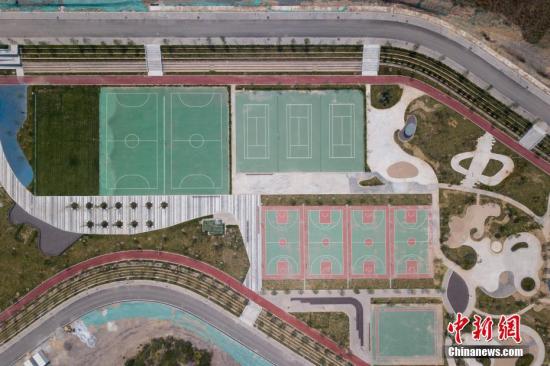China News Service, April 27. According to the WeChat official account of the National Development and Reform Commission, the National Development and Reform Commission and the General Administration of Sports have jointly issued the "Implementation Plan for the Shortcomings of National Fitness Facilities during the "14th Five-Year" Period" (hereinafter referred to as the "Implementation Plan") .
Among them, it is proposed that by 2025, the national per capita sports area will reach more than 2.6 square meters, the number of football venues per 10,000 people will reach more than 0.9, the national fitness facilities will be more equitable and accessible, the outdoor sports public service facilities will be gradually improved, and the supply will be abundant. , With a reasonable layout and a well-functioning fitness facility network, the problem of where the masses go for fitness is gradually solved.
Data map: Taiyuan City, Shanxi Province, aerial photography of a sports park covering an area of about 180 acres.
Photo by China News Agency reporter Wei Liang
The "Implementation Plan" focuses on fitness facilities around the masses and adheres to the green, low-carbon, and practical construction concept.
During the "14th Five-Year Plan" period, the central budget will focus on supporting the construction of 6 types of projects including sports parks, national fitness centers (small sports complexes), public stadiums, social football fields, fitness trails, and public service facilities for outdoor sports.
Among them, the national fitness center, public stadiums, and social football fields are the support directions for the continuation of the "13th Five-Year Plan", and sports parks, fitness trails, and public service facilities for outdoor sports are the new support directions for the "14th Five-Year Plan".
In principle, the investment in the central budget for projects in the eastern, central and western regions (including regions that enjoy central and western policies according to relevant national policies) shall not exceed the total approved investment (excluding land costs and municipal costs, which are only engineering construction investments). The proportions of 30%, 60% and 80% are supported.
In principle, the construction funds of the Tibet Autonomous Region and the four prefectures in southern Xinjiang are fully supported by the central budget. Projects in the four provinces and counties related to Tibet can be fully supported by the central budget. Areas enjoying special regional development policies are implemented in accordance with specific policy requirements.
On the basis of the above support ratio, the maximum support limit for sports parks and national fitness centers (small sports complexes) does not exceed 20 million yuan, and the maximum support limit for fitness trails and outdoor sports public service facilities does not exceed 10 million yuan. The track and field track and standard football field are calculated according to the average total investment of 6 million yuan, the 11-a-side standard football field is calculated according to the average total investment of 3 million yuan, and the fixed support for each piece of other standard football fields is 300,000 to 500,000 yuan.
Local development and reform and sports departments will establish a working mechanism to jointly do a good job in the reserve, organization, coordination, and supervision of the project to ensure that the project starts in a timely manner, and the inspection and acceptance will be organized in a timely manner after completion. The National Development and Reform Commission and the General Administration of Sport will organize inspections and evaluations at the right time, reward places that have worked hard and have achieved remarkable results, and punish places where central government funds are not sufficiently supervised.

